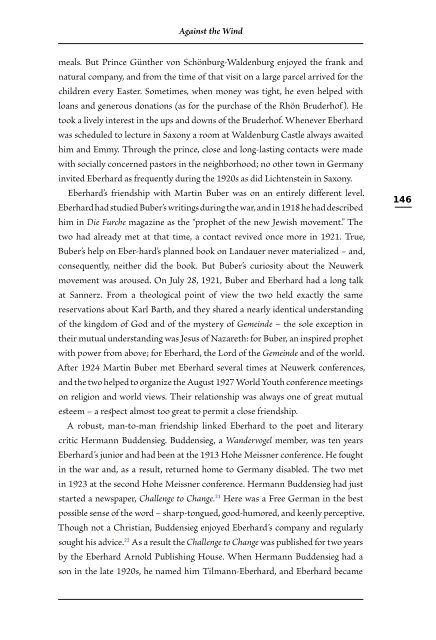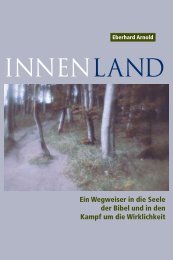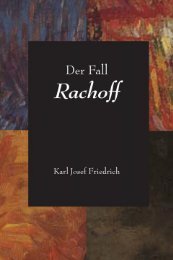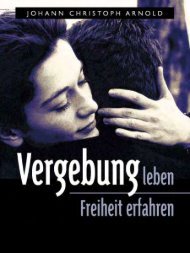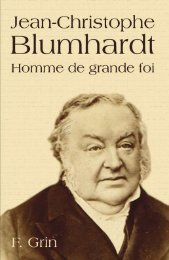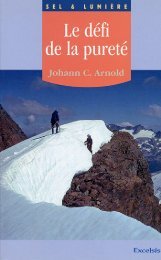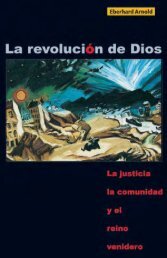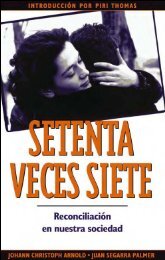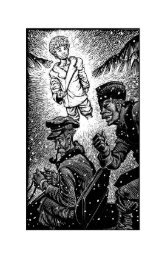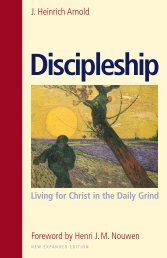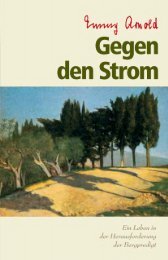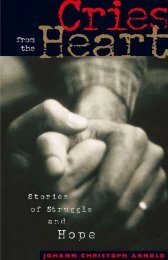Against the Wind: Eberhard Arnold and the Bruderhof - Plough
Against the Wind: Eberhard Arnold and the Bruderhof - Plough
Against the Wind: Eberhard Arnold and the Bruderhof - Plough
You also want an ePaper? Increase the reach of your titles
YUMPU automatically turns print PDFs into web optimized ePapers that Google loves.
<strong>Against</strong> <strong>the</strong> <strong>Wind</strong><br />
meals. But Prince Gün<strong>the</strong>r von Schönburg-Waldenburg enjoyed <strong>the</strong> frank <strong>and</strong><br />
natural company, <strong>and</strong> from <strong>the</strong> time of that visit on a large parcel arrived for <strong>the</strong><br />
children every Easter. Sometimes, when money was tight, he even helped with<br />
loans <strong>and</strong> generous donations (as for <strong>the</strong> purchase of <strong>the</strong> Rhön <strong>Bruderhof</strong>). He<br />
took a lively interest in <strong>the</strong> ups <strong>and</strong> downs of <strong>the</strong> <strong>Bruderhof</strong>. Whenever <strong>Eberhard</strong><br />
was scheduled to lecture in Saxony a room at Waldenburg Castle always awaited<br />
him <strong>and</strong> Emmy. Through <strong>the</strong> prince, close <strong>and</strong> long-lasting contacts were made<br />
with socially concerned pastors in <strong>the</strong> neighborhood; no o<strong>the</strong>r town in Germany<br />
invited <strong>Eberhard</strong> as frequently during <strong>the</strong> 1920s as did Lichtenstein in Saxony.<br />
<strong>Eberhard</strong>’s friendship with Martin Buber was on an entirely different level.<br />
<strong>Eberhard</strong> had studied Buber’s writings during <strong>the</strong> war, <strong>and</strong> in 1918 he had described<br />
him in Die Furche magazine as <strong>the</strong> “prophet of <strong>the</strong> new Jewish movement.” The<br />
two had already met at that time, a contact revived once more in 1921. True,<br />
Buber’s help on Eber-hard’s planned book on L<strong>and</strong>auer never materialized – <strong>and</strong>,<br />
consequently, nei<strong>the</strong>r did <strong>the</strong> book. But Buber’s curiosity about <strong>the</strong> Neuwerk<br />
movement was aroused. On July 28, 1921, Buber <strong>and</strong> <strong>Eberhard</strong> had a long talk<br />
at Sannerz. From a <strong>the</strong>ological point of view <strong>the</strong> two held exactly <strong>the</strong> same<br />
reservations about Karl Barth, <strong>and</strong> <strong>the</strong>y shared a nearly identical underst<strong>and</strong>ing<br />
of <strong>the</strong> kingdom of God <strong>and</strong> of <strong>the</strong> mystery of Gemeinde – <strong>the</strong> sole exception in<br />
<strong>the</strong>ir mutual underst<strong>and</strong>ing was Jesus of Nazareth: for Buber, an inspired prophet<br />
with power from above; for <strong>Eberhard</strong>, <strong>the</strong> Lord of <strong>the</strong> Gemeinde <strong>and</strong> of <strong>the</strong> world.<br />
After 1924 Martin Buber met <strong>Eberhard</strong> several times at Neuwerk conferences,<br />
<strong>and</strong> <strong>the</strong> two helped to organize <strong>the</strong> August 1927 World Youth conference meetings<br />
on religion <strong>and</strong> world views. Their relationship was always one of great mutual<br />
eseem – a resect almost too great to permit a close friendship.<br />
A robust, man-to-man friendship linked <strong>Eberhard</strong> to <strong>the</strong> poet <strong>and</strong> literary<br />
critic Hermann Buddensieg. Buddensieg, a W<strong>and</strong>ervogel member, was ten years<br />
<strong>Eberhard</strong>’s junior <strong>and</strong> had been at <strong>the</strong> 1913 Hohe Meissner conference. He fought<br />
in <strong>the</strong> war <strong>and</strong>, as a result, returned home to Germany disabled. The two met<br />
in 1923 at <strong>the</strong> second Hohe Meissner conference. Hermann Buddensieg had just<br />
started a newspaper, Challenge to Change. 21 Here was a Free German in <strong>the</strong> best<br />
possible sense of <strong>the</strong> word – sharp-tongued, good-humored, <strong>and</strong> keenly perceptive.<br />
Though not a Christian, Buddensieg enjoyed <strong>Eberhard</strong>’s company <strong>and</strong> regularly<br />
sought his advice. 22 As a result <strong>the</strong> Challenge to Change was published for two years<br />
by <strong>the</strong> <strong>Eberhard</strong> <strong>Arnold</strong> Publishing House. When Hermann Buddensieg had a<br />
son in <strong>the</strong> late 1920s, he named him Tilmann-<strong>Eberhard</strong>, <strong>and</strong> <strong>Eberhard</strong> became<br />
146


